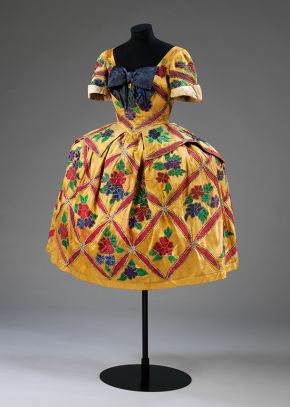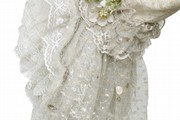Reflecting Historical Periods in Stage Costume
Der Rosenkavalier
Richard Strauss's Der Rosenkavalier is a pastiche, evoking the golden age of 18th-century Vienna, and the designer has to suggest, often on a limited budget, the richness and opulence of the period and the aristocratic world in which the characters move.
David Walker's costumes for English National Opera in 1974 were an imaginative and visually stunning adaptation of 18th-century fashion. As singers need as little restriction as possible over the upper body, correct period corseting is out of the question, and the key objective is to maintain the impression of a period shape.
The costume is a fantasy dress for a pure young girl. The volume of the skirt and the boldness of the decoration are exaggerated. The effect of delicacy is achieved by building up layers of fabrics and nets, woven with metallic threads and trimmed with laces and flowers, rather than using a single solid fabric. The top surface is then encrusted with laces and braids to give the wonderful texture. While the period feel is maintained, the costumiers have used fabrics of the 1970s such as lurex, and the flowers trimming the lace are plastic. From the audience, the effect is very convincing.

Costume for Mariuccia in Leonide Massine's ballet 'The Good-Humoured Ladies', designed by Leon Bakst, Diaghilev Ballet Russes, 1917. Musem no. S.148-1985
The Good-Humoured Ladies
18th century women's costume was cumbersome, voluminous and restricting, characteristics that make it unsuitable for ballet dancers.
However, this was the task facing LЈІon Bakst for Leonide Massine's 1917 ballet The Good-Humoured Ladies, a comedy of manners based on a play by the 18th-century Italian dramatist Goldoni.
Bakst adapted period dress taking into account the particular style of the choreography. His solution in the costume for Mariuccia was to shorten the skirt - which was in keeping with her character as a servant - and sleeves, so that Massine's very detailed footwork and hand movements would be clear. The shape was kept light and clear. The internal structure kept the fabric away from the legs, and fabric and frills were minimised; the decoration was appliquЈІd onto the costume using silver chain stitch.
The clarity of outline and the brilliant yellow, purple, green and blue - all most un-18th century colours - help make the costume feel modern and fresh.
The ballet was extremely popular and often revived. In the remaking, the detail became eroded and the expensive appliquЈІ was replaced by a stencilled design.
- ЩЯвЛЦЊЃКЗДгГдкЮшЬЈЗўзАРњЪЗЪБЦк 2013/12/8
- ЯТвЛЦЊЃКЩшМЦЮшЬЈЗўзА 2013/12/8





